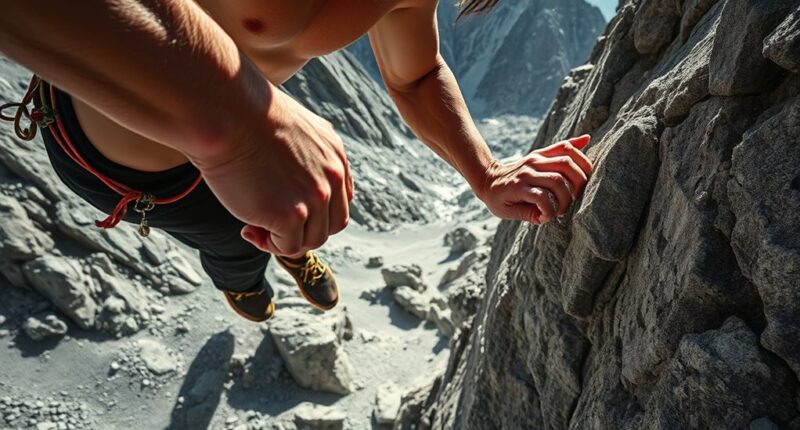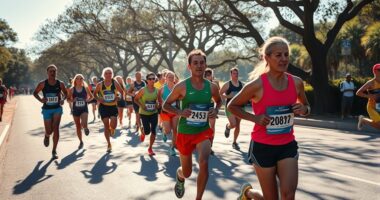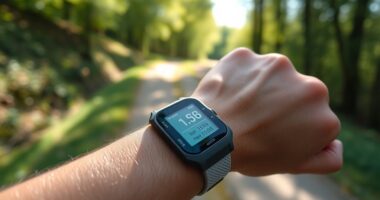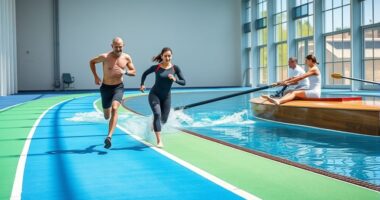The biomechanics of descents and ascents involve different muscle roles and movement patterns. During ascents, you rely on concentric contractions in your quadriceps, glutes, and calves to lift your body, conserving energy through proper technique. Descents involve eccentric muscle actions that control your speed and absorb impact, reducing joint stress. Understanding how your muscles, joints, and posture work together can boost efficiency and safety—continue exploring to master these movements fully.
Key Takeaways
- Ascents primarily involve concentric muscle contractions of quadriceps, glutes, and calves to lift the body against gravity.
- Descents utilize eccentric muscle actions to control movement, absorb impact, and maintain stability.
- Proper technique during ascents optimizes muscle recruitment, conserving energy and reducing joint stress.
- During descents, leaning back slightly and engaging core enhances control and prevents overloading joints.
- Efficient biomechanics in both movements improve performance, reduce injury risk, and promote energy conservation.
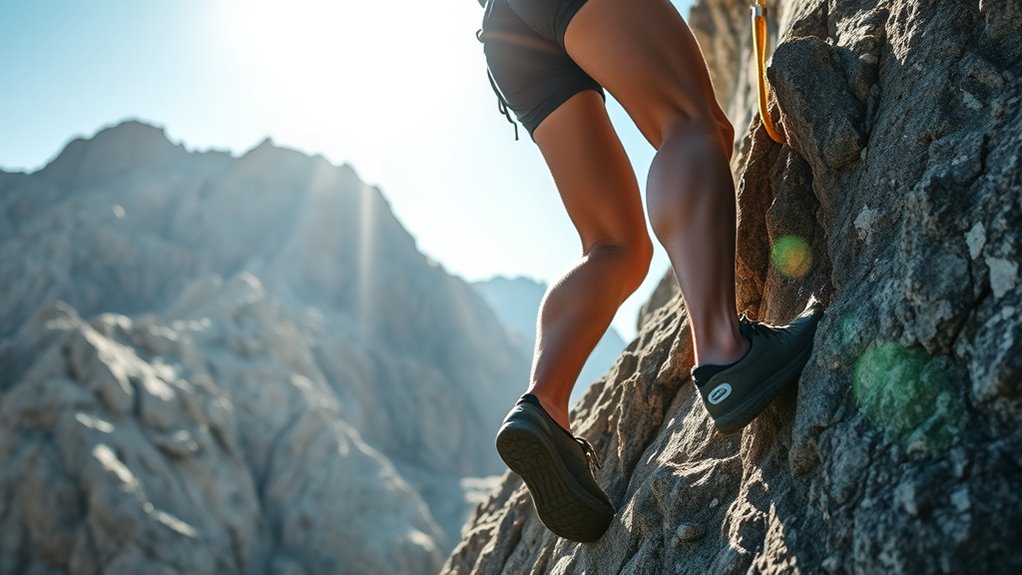
Understanding the biomechanics of descents and ascents is essential for optimizing performance and preventing injury during physical activities like hiking, climbing, and skiing. When you ascend, your muscles activate in specific patterns to generate the force needed to lift your body against gravity. You rely heavily on your quadriceps, glutes, and calves, which work together to push you upward. The way these muscles activate influences your energy expenditure; more efficient muscle activation means less energy wasted, allowing you to conserve stamina over longer periods. During ascents, your body recruits muscle fibers in a coordinated manner, increasing the efficiency of movement and reducing undue fatigue. Proper engagement of these muscles not only improves your ascent but also minimizes stress on joints, reducing injury risk. Additionally, understanding the role of athletic performance can help you develop better training strategies to enhance your endurance and strength during these activities. Descending involves a different set of biomechanical principles. As you go downhill, your muscles act eccentrically, meaning they lengthen under tension to control your movement and absorb impact forces. Your quadriceps and calves are especially active here, working to slow your descent and maintain stability. Eccentric muscle activation is less energy-intensive than concentric contractions, but it still contributes markedly to your overall energy expenditure. If you don’t engage these muscles correctly, you risk losing control or overloading certain joints, which can lead to strains or falls. Understanding how muscle activation patterns shift during descents allows you to adjust your technique for better control, reducing fatigue and injury potential. The differences in biomechanics between ascents and descents also influence your overall energy expenditure. Climbing demands more energy because your muscles perform concentric contractions, which are more taxing than the eccentric actions used during descent. Efficient movement techniques, such as using your hips and core to generate power, can help you conserve energy and reduce fatigue. When descending, controlling your speed and posture minimizes unnecessary muscle activation, helping you manage your energy reserves better. Proper technique—like leaning slightly back during descents or engaging your core—can improve stability and make both ascents and descents more energy-efficient. Recognizing how your muscles activate and how energy is expended in each phase helps you develop a balanced approach, enhancing endurance while safeguarding your joints and muscles from strain or injury.
Frequently Asked Questions
How Do Footwear Choices Impact Descent and Ascent Biomechanics?
Your footwear choices substantially impact your descent and ascent biomechanics. Shoes with proper cushioning absorb shock and reduce fatigue, allowing smoother movements. Traction design ensures stability on varied surfaces, preventing slips and enhancing control. When choosing footwear, prioritize cushioning to protect your joints and traction features for safety. This combination optimizes your efficiency and reduces injury risk during downhill and uphill activities, helping you perform confidently and comfortably.
What Role Does Muscle Fatigue Play During Prolonged Descents and Ascents?
During prolonged descents and ascents, muscle fatigue especially impacts your performance by reducing muscle endurance and increasing the risk of injury. As your muscles tire, your form and stability suffer, making fatigue management vital. To combat this, you should pace yourself, incorporate rest periods, and focus on proper technique. This helps maintain efficiency, preserves muscle strength, and prevents overexertion, allowing you to complete your activities safely and effectively.
How Do Environmental Factors Influence Biomechanical Efficiency?
Environmental factors act like unpredictable weather, shaping your biomechanical efficiency on the move. When surface conditions are slick or uneven, you must adapt your stance and stride, wasting energy trying to stay balanced. Weather variability, like wind or rain, adds resistance or reduces traction, forcing your muscles to work harder. Staying alert and adjusting your technique helps you conserve energy and maintain ideal efficiency despite these environmental challenges.
Are There Gender Differences in Descent and Ascent Biomechanics?
Yes, gender differences influence descent and ascent biomechanics. You might notice biomechanical variations, such as differences in joint angles, muscle activation, and force production, which affect performance and injury risk. These variations stem from anatomical and physiological disparities between genders, impacting how you move during physical activities. Understanding these differences helps tailor training and injury prevention strategies, ensuring more effective and safer movement patterns for everyone.
How Can Biomechanical Analysis Prevent Injuries During Mountain Activities?
Imagine a hiker avoiding a knee injury by refining their downhill technique. Biomechanical analysis helps you optimize your technique, reducing undue stress on joints and muscles. By identifying improper gait patterns or posture, you can make targeted adjustments that prevent injuries. This proactive approach is essential for injury prevention during mountain activities, ensuring you stay safe and enjoy your adventures longer. Proper biomechanics keep you balanced and resilient on challenging terrains.
Conclusion
Remember, practice makes perfect, especially when it comes to mastering climbs and descents. By understanding the biomechanics involved, you can improve your efficiency and reduce injury risk. Pay attention to your body’s movements, stay balanced, and adapt your technique as needed. Keep pushing your limits, but do so wisely—after all, Rome wasn’t built in a day. With consistency and awareness, you’ll elevate your performance and enjoy every ride.
